

Compact Muon Solenoid
LHC, CERN
| CMS-PAS-HIG-24-002 | ||
| Search for heavy scalar resonances decaying to a pair of Z bosons in the 4-lepton final state at 13 TeV | ||
| CMS Collaboration | ||
| 20 July 2024 | ||
| Abstract: A search for a heavy scalar resonance decaying to two Z bosons and subsequently to four leptons is presented, where the leptons can be electrons or muons. The results are based on the proton-proton collision data collected by the CMS experiment at the LHC at a center-of-mass energy of 13 TeV, corresponding to an integrated luminosity of 138 fb$^{-1}$. The searches are performed in a model independent way over a range of resonance mass from 130 GeV to 3 TeV, considering both narrow and wide width scenarios, and assuming that the resonance is produced via gluon fusion or vector boson fusion. For the wide width scenarios, the interference between the signal, the standard model Higgs production, and the continuum background are taken into account. No significant excess with respect to the standard model predictions is observed in the examined phase space, and upper limits at 95% confidence level on the production cross section of the resonance multiplied by the branching ratio of decaying to two Z bosons are computed. | ||
| Links: CDS record (PDF) ; Physics Briefing ; CADI line (restricted) ; | ||
| Figures | |
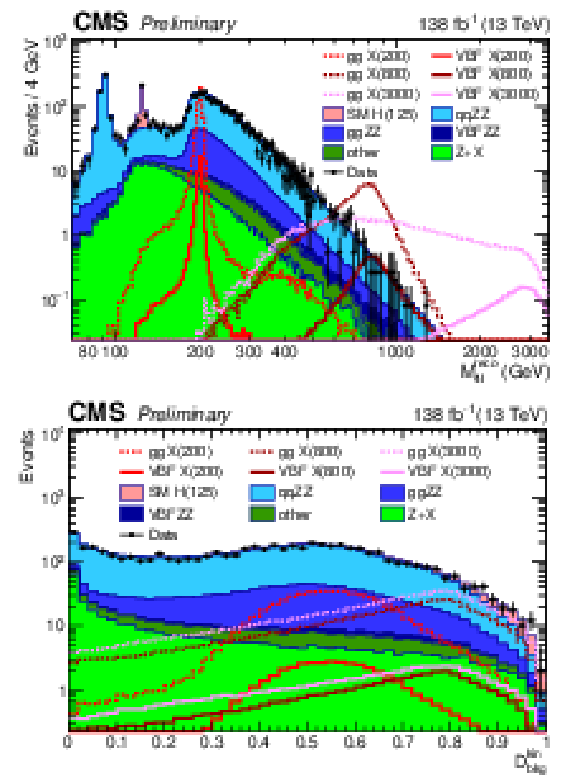
png pdf |
Figure 1:
Left: the $ M_{4\ell}^{\text{reco}} $ distributions of signal and background processes estimated from the MC simulation. Observed data are superimposed as well. The signal lineshapes shown in the plot show the width predicted by the CPS, describing the shape of an SM-like Higgs boson with different masses. Right: The $ D_\text{bkg}^{\text{kin}} $ distributions of signal and background processes estimated from the MC simulation, together with the observed data. |
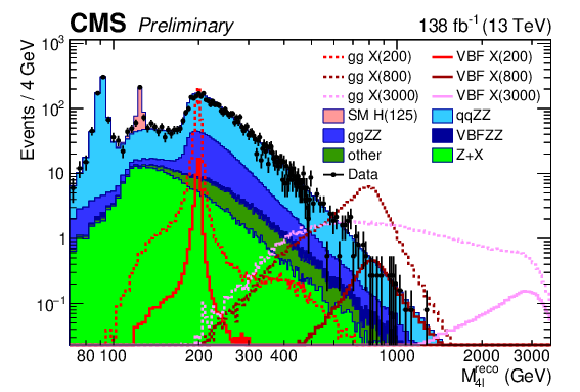
png pdf |
Figure 1-a:
Left: the $ M_{4\ell}^{\text{reco}} $ distributions of signal and background processes estimated from the MC simulation. Observed data are superimposed as well. The signal lineshapes shown in the plot show the width predicted by the CPS, describing the shape of an SM-like Higgs boson with different masses. Right: The $ D_\text{bkg}^{\text{kin}} $ distributions of signal and background processes estimated from the MC simulation, together with the observed data. |
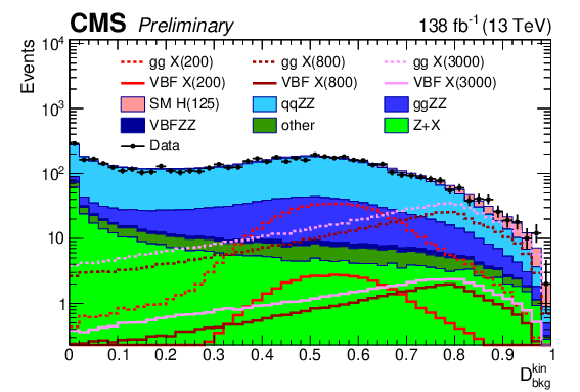
png pdf |
Figure 1-b:
Left: the $ M_{4\ell}^{\text{reco}} $ distributions of signal and background processes estimated from the MC simulation. Observed data are superimposed as well. The signal lineshapes shown in the plot show the width predicted by the CPS, describing the shape of an SM-like Higgs boson with different masses. Right: The $ D_\text{bkg}^{\text{kin}} $ distributions of signal and background processes estimated from the MC simulation, together with the observed data. |
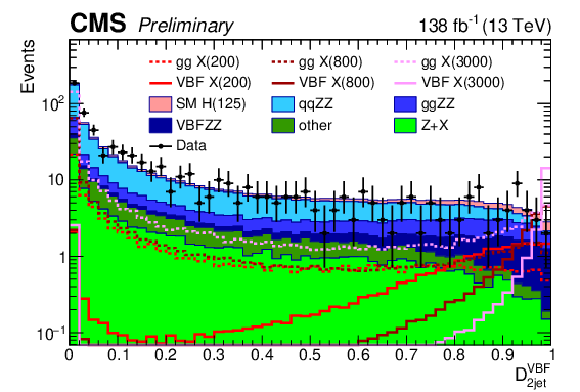
png pdf |
Figure 2:
The $ D_\text{2jet}^{\text{VBF}} $ distribution of signal and background processes together with observed data, combining the full Run 2 dataset. Only events passing the lepton and jet number selections for the VBF-tagging category contribute to this distribution. To be selected in the VBF-tagged category, events are required to have $ D_\text{2jet}^{\text{VBF}} > $ 0.46. |
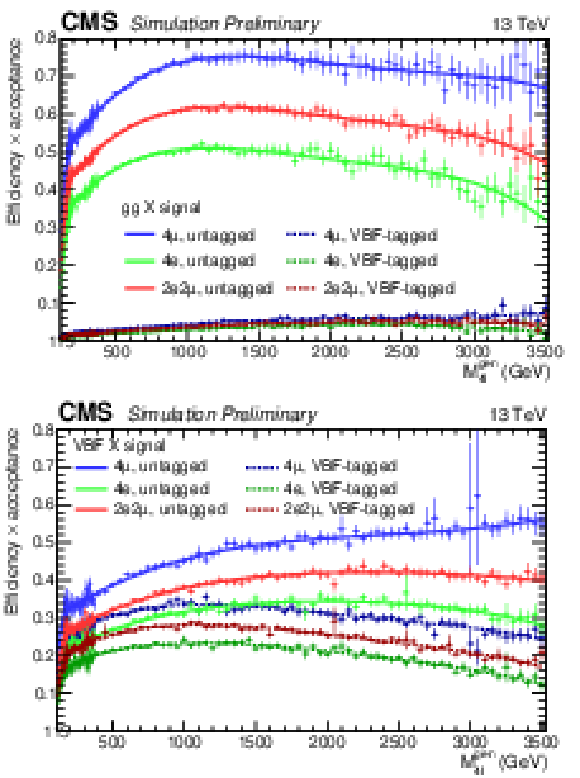
png pdf |
Figure 3:
The signal efficiency times acceptance as a function of $ M_{4\ell}^{\text{gen}} $ computed for the 2018 dataset. The left plot shows the results of ggF signals, and the right plot shows those of VBF signals. In each plot, the efficiency times acceptance in each final state and category is shown: blue dots and curves represents the 4$ \mu $ final state, green ones represents the 4e final state, and red ones represents the 2e2$\mu $ final state; the solid lines with lighter colors represent the untagged category, and the dashed lines with darker colors represent the VBF-tagged category. Both the data points and fitted curves are shown. In other data taking periods, the results are similar. |

png pdf |
Figure 3-a:
The signal efficiency times acceptance as a function of $ M_{4\ell}^{\text{gen}} $ computed for the 2018 dataset. The left plot shows the results of ggF signals, and the right plot shows those of VBF signals. In each plot, the efficiency times acceptance in each final state and category is shown: blue dots and curves represents the 4$ \mu $ final state, green ones represents the 4e final state, and red ones represents the 2e2$\mu $ final state; the solid lines with lighter colors represent the untagged category, and the dashed lines with darker colors represent the VBF-tagged category. Both the data points and fitted curves are shown. In other data taking periods, the results are similar. |

png pdf |
Figure 3-b:
The signal efficiency times acceptance as a function of $ M_{4\ell}^{\text{gen}} $ computed for the 2018 dataset. The left plot shows the results of ggF signals, and the right plot shows those of VBF signals. In each plot, the efficiency times acceptance in each final state and category is shown: blue dots and curves represents the 4$ \mu $ final state, green ones represents the 4e final state, and red ones represents the 2e2$\mu $ final state; the solid lines with lighter colors represent the untagged category, and the dashed lines with darker colors represent the VBF-tagged category. Both the data points and fitted curves are shown. In other data taking periods, the results are similar. |

png pdf |
Figure 4:
The signal $ M_{4\ell}^{\text{reco}} $ shapes with different $ M_\mathrm{X} $, $ \Gamma_\mathrm{X} $, produced via ggF (left) or VBF (right). |

png pdf |
Figure 4-a:
The signal $ M_{4\ell}^{\text{reco}} $ shapes with different $ M_\mathrm{X} $, $ \Gamma_\mathrm{X} $, produced via ggF (left) or VBF (right). |

png pdf |
Figure 4-b:
The signal $ M_{4\ell}^{\text{reco}} $ shapes with different $ M_\mathrm{X} $, $ \Gamma_\mathrm{X} $, produced via ggF (left) or VBF (right). |
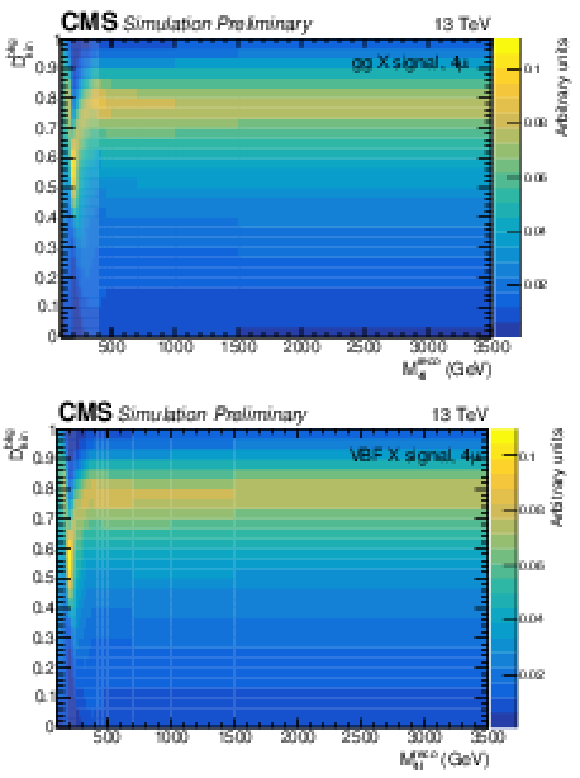
png pdf |
Figure 5:
The distributions of $ M_{4\ell}^{\text{gen}} $ v.s. $ D_\text{bkg}^{\text{kin}} $ for the ggF (left) and VBF (right) production mechanism, in the 4 $ \mu $ final state, estimated from the signal simulation. No categorization is applied. |

png pdf |
Figure 5-a:
The distributions of $ M_{4\ell}^{\text{gen}} $ v.s. $ D_\text{bkg}^{\text{kin}} $ for the ggF (left) and VBF (right) production mechanism, in the 4 $ \mu $ final state, estimated from the signal simulation. No categorization is applied. |
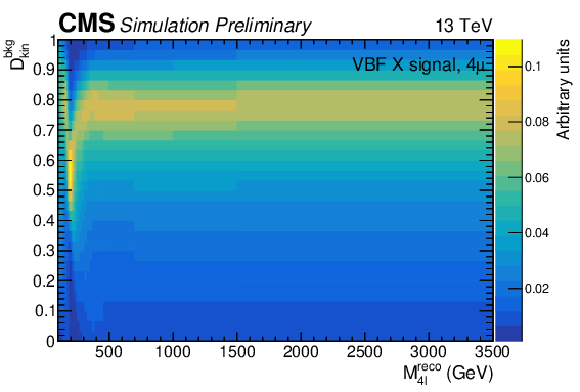
png pdf |
Figure 5-b:
The distributions of $ M_{4\ell}^{\text{gen}} $ v.s. $ D_\text{bkg}^{\text{kin}} $ for the ggF (left) and VBF (right) production mechanism, in the 4 $ \mu $ final state, estimated from the signal simulation. No categorization is applied. |
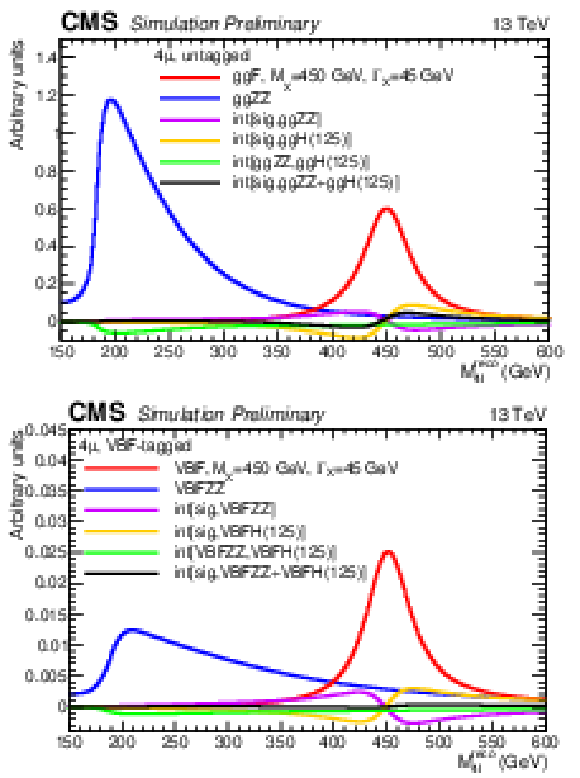
png pdf |
Figure 6:
Examples of interference lineshapes. The left (right) plot depicts the lineshape of the ggF (VBF) signal with $ M_\mathrm{X}= $ 450 GeV, $ \Gamma_\mathrm{X}= $ 45 GeV in the red curve, the lineshape of the $ \mathrm{g}\mathrm{g}\to\mathrm{Z}\mathrm{Z} $ (VBFZZ) background in the blue curve, and the lineshapes of the three interferences in the violet, orange and green curves. The left plot is in the 4 $ \mu $ final state and untagged category; the right plot is in the 4 $ \mu $ final state and VBF-tagged category. |
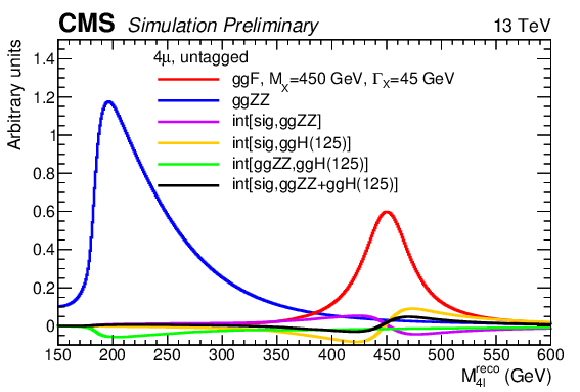
png pdf |
Figure 6-a:
Examples of interference lineshapes. The left (right) plot depicts the lineshape of the ggF (VBF) signal with $ M_\mathrm{X}= $ 450 GeV, $ \Gamma_\mathrm{X}= $ 45 GeV in the red curve, the lineshape of the $ \mathrm{g}\mathrm{g}\to\mathrm{Z}\mathrm{Z} $ (VBFZZ) background in the blue curve, and the lineshapes of the three interferences in the violet, orange and green curves. The left plot is in the 4 $ \mu $ final state and untagged category; the right plot is in the 4 $ \mu $ final state and VBF-tagged category. |

png pdf |
Figure 6-b:
Examples of interference lineshapes. The left (right) plot depicts the lineshape of the ggF (VBF) signal with $ M_\mathrm{X}= $ 450 GeV, $ \Gamma_\mathrm{X}= $ 45 GeV in the red curve, the lineshape of the $ \mathrm{g}\mathrm{g}\to\mathrm{Z}\mathrm{Z} $ (VBFZZ) background in the blue curve, and the lineshapes of the three interferences in the violet, orange and green curves. The left plot is in the 4 $ \mu $ final state and untagged category; the right plot is in the 4 $ \mu $ final state and VBF-tagged category. |
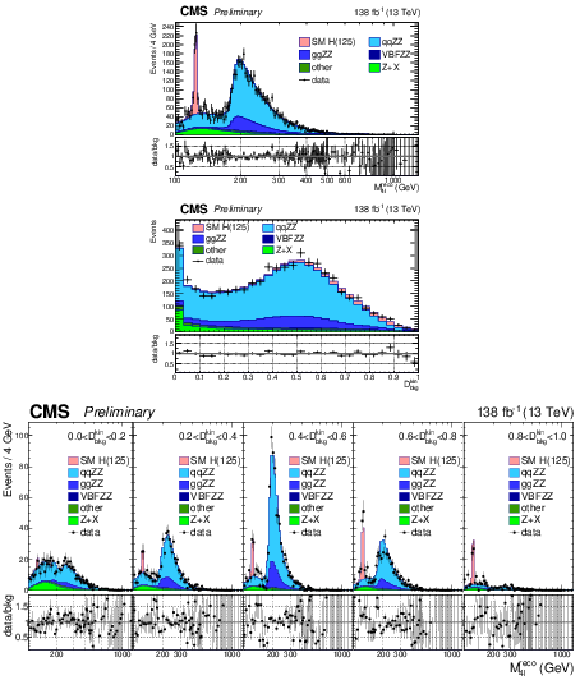
png pdf |
Figure 7:
The $ M_{4\ell}^{\text{reco}} $ and $ D_\text{bkg}^{\text{kin}} $ distributions with the full Run 2 dataset, for backgrounds and observed data. The distributions for backgrounds are extracted from the statistical model, with all nuisance parameters at their best-fit values (post-fit). The top left plot shows the distribution of $ M_{4\ell}^{\text{reco}} $; the top right plot shows the distribution of $ D_\text{bkg}^{\text{kin}} $; the bottom plot shows the distribution of $ M_{4\ell}^{\text{reco}} $ in bins of $ D_\text{bkg}^{\text{kin}} $. |
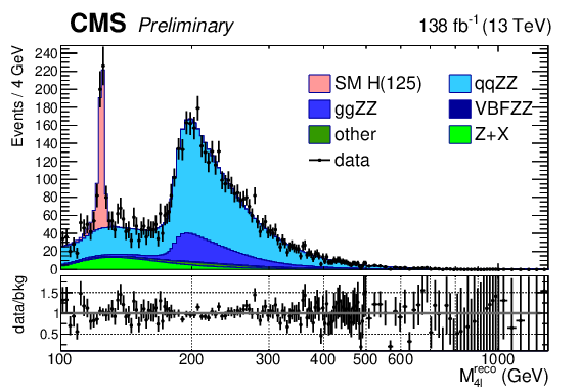
png pdf |
Figure 7-a:
The $ M_{4\ell}^{\text{reco}} $ and $ D_\text{bkg}^{\text{kin}} $ distributions with the full Run 2 dataset, for backgrounds and observed data. The distributions for backgrounds are extracted from the statistical model, with all nuisance parameters at their best-fit values (post-fit). The top left plot shows the distribution of $ M_{4\ell}^{\text{reco}} $; the top right plot shows the distribution of $ D_\text{bkg}^{\text{kin}} $; the bottom plot shows the distribution of $ M_{4\ell}^{\text{reco}} $ in bins of $ D_\text{bkg}^{\text{kin}} $. |

png pdf |
Figure 7-b:
The $ M_{4\ell}^{\text{reco}} $ and $ D_\text{bkg}^{\text{kin}} $ distributions with the full Run 2 dataset, for backgrounds and observed data. The distributions for backgrounds are extracted from the statistical model, with all nuisance parameters at their best-fit values (post-fit). The top left plot shows the distribution of $ M_{4\ell}^{\text{reco}} $; the top right plot shows the distribution of $ D_\text{bkg}^{\text{kin}} $; the bottom plot shows the distribution of $ M_{4\ell}^{\text{reco}} $ in bins of $ D_\text{bkg}^{\text{kin}} $. |
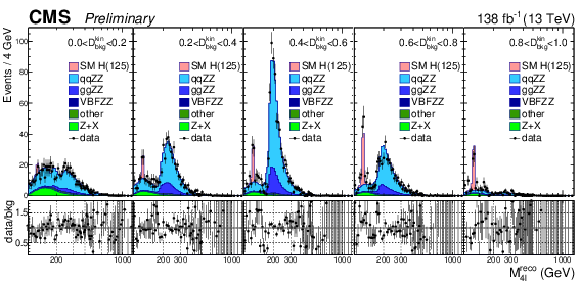
png pdf |
Figure 7-c:
The $ M_{4\ell}^{\text{reco}} $ and $ D_\text{bkg}^{\text{kin}} $ distributions with the full Run 2 dataset, for backgrounds and observed data. The distributions for backgrounds are extracted from the statistical model, with all nuisance parameters at their best-fit values (post-fit). The top left plot shows the distribution of $ M_{4\ell}^{\text{reco}} $; the top right plot shows the distribution of $ D_\text{bkg}^{\text{kin}} $; the bottom plot shows the distribution of $ M_{4\ell}^{\text{reco}} $ in bins of $ D_\text{bkg}^{\text{kin}} $. |

png pdf |
Figure 8:
The upper limits on $ \sigma(\mathrm{p}\mathrm{p}\to\mathrm{X}\to\mathrm{Z}\mathrm{Z}) $ with $ M_\mathrm{X} $ from 130 GeV to 3 TeV and narrow width assumption. The top left plot shows the results of pure ggF production; the top right plot shows the pure VBF production; and the bottom plot shows the results with $ f_\text{VBF} $ floating. |
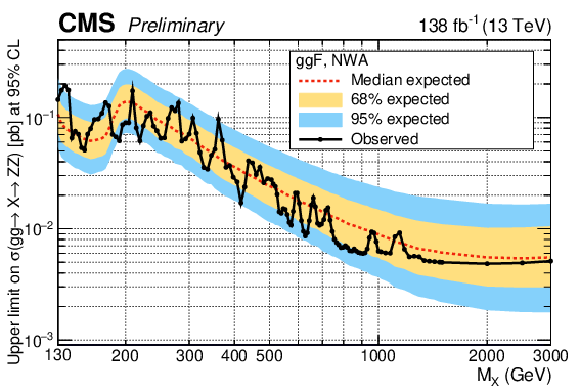
png pdf |
Figure 8-a:
The upper limits on $ \sigma(\mathrm{p}\mathrm{p}\to\mathrm{X}\to\mathrm{Z}\mathrm{Z}) $ with $ M_\mathrm{X} $ from 130 GeV to 3 TeV and narrow width assumption. The top left plot shows the results of pure ggF production; the top right plot shows the pure VBF production; and the bottom plot shows the results with $ f_\text{VBF} $ floating. |

png pdf |
Figure 8-b:
The upper limits on $ \sigma(\mathrm{p}\mathrm{p}\to\mathrm{X}\to\mathrm{Z}\mathrm{Z}) $ with $ M_\mathrm{X} $ from 130 GeV to 3 TeV and narrow width assumption. The top left plot shows the results of pure ggF production; the top right plot shows the pure VBF production; and the bottom plot shows the results with $ f_\text{VBF} $ floating. |
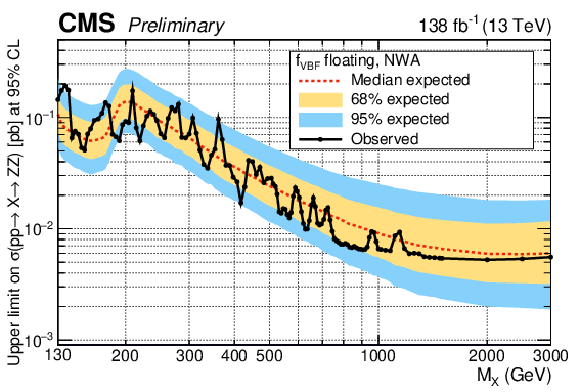
png pdf |
Figure 8-c:
The upper limits on $ \sigma(\mathrm{p}\mathrm{p}\to\mathrm{X}\to\mathrm{Z}\mathrm{Z}) $ with $ M_\mathrm{X} $ from 130 GeV to 3 TeV and narrow width assumption. The top left plot shows the results of pure ggF production; the top right plot shows the pure VBF production; and the bottom plot shows the results with $ f_\text{VBF} $ floating. |
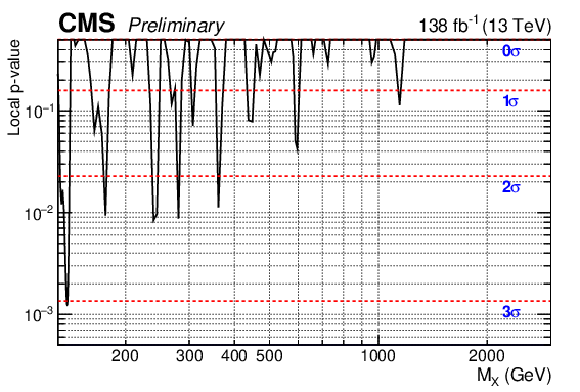
png pdf |
Figure 9:
The local p-value as a function of $ M_\mathrm{X} $, with $ f_\text{VBF} $ floating. |

png pdf |
Figure 10:
The expected upper limits on $ \sigma(\mathrm{p}\mathrm{p}\to\mathrm{X}\to\mathrm{Z}\mathrm{Z}) $ with $ M _{\mathrm{X}} $ from 130 GeV to 3 TeV and $ \Gamma _{\mathrm{X}}= $ 1 (top), 10 (middle) and 100 (bottom) GeV. The left column shows the results of pure ggF production and the right column shows the pure VBF production. |
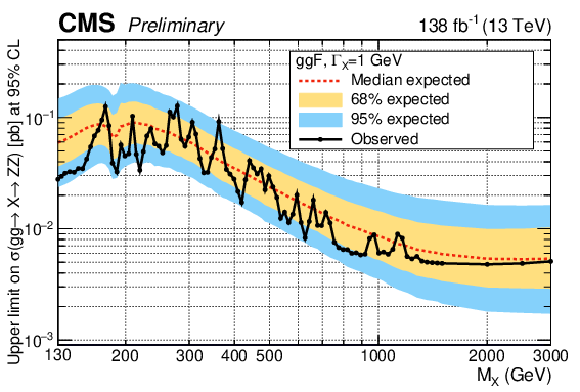
png pdf |
Figure 10-a:
The expected upper limits on $ \sigma(\mathrm{p}\mathrm{p}\to\mathrm{X}\to\mathrm{Z}\mathrm{Z}) $ with $ M _{\mathrm{X}} $ from 130 GeV to 3 TeV and $ \Gamma _{\mathrm{X}}= $ 1 (top), 10 (middle) and 100 (bottom) GeV. The left column shows the results of pure ggF production and the right column shows the pure VBF production. |
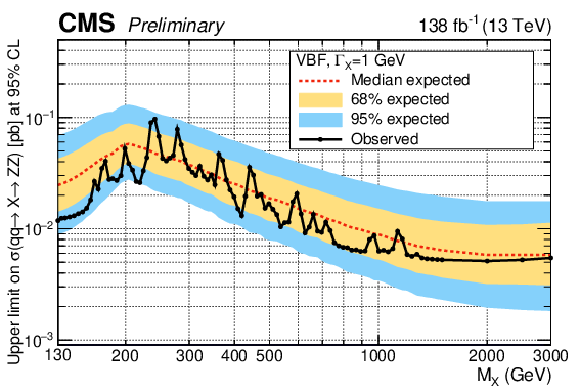
png pdf |
Figure 10-b:
The expected upper limits on $ \sigma(\mathrm{p}\mathrm{p}\to\mathrm{X}\to\mathrm{Z}\mathrm{Z}) $ with $ M _{\mathrm{X}} $ from 130 GeV to 3 TeV and $ \Gamma _{\mathrm{X}}= $ 1 (top), 10 (middle) and 100 (bottom) GeV. The left column shows the results of pure ggF production and the right column shows the pure VBF production. |
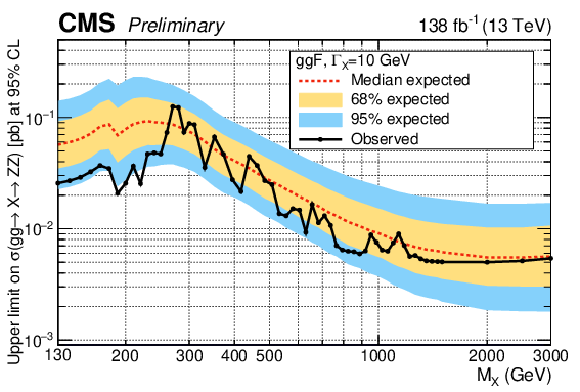
png pdf |
Figure 10-c:
The expected upper limits on $ \sigma(\mathrm{p}\mathrm{p}\to\mathrm{X}\to\mathrm{Z}\mathrm{Z}) $ with $ M _{\mathrm{X}} $ from 130 GeV to 3 TeV and $ \Gamma _{\mathrm{X}}= $ 1 (top), 10 (middle) and 100 (bottom) GeV. The left column shows the results of pure ggF production and the right column shows the pure VBF production. |
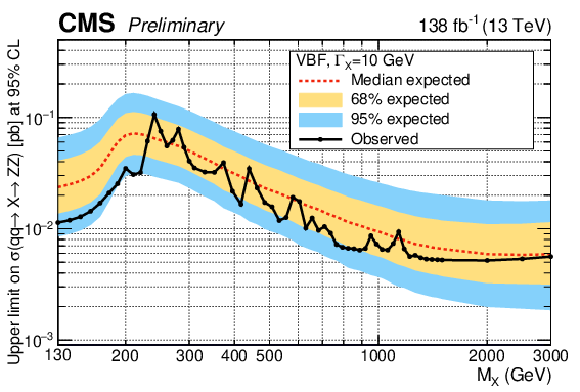
png pdf |
Figure 10-d:
The expected upper limits on $ \sigma(\mathrm{p}\mathrm{p}\to\mathrm{X}\to\mathrm{Z}\mathrm{Z}) $ with $ M _{\mathrm{X}} $ from 130 GeV to 3 TeV and $ \Gamma _{\mathrm{X}}= $ 1 (top), 10 (middle) and 100 (bottom) GeV. The left column shows the results of pure ggF production and the right column shows the pure VBF production. |
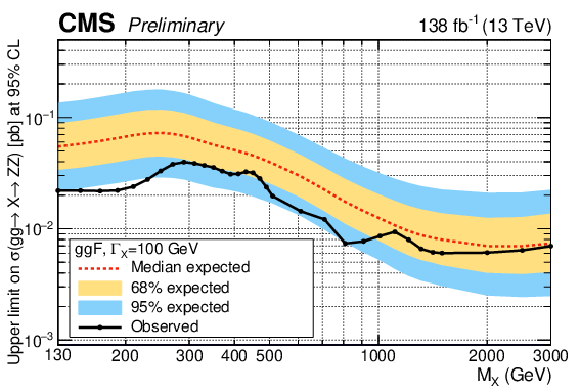
png pdf |
Figure 10-e:
The expected upper limits on $ \sigma(\mathrm{p}\mathrm{p}\to\mathrm{X}\to\mathrm{Z}\mathrm{Z}) $ with $ M _{\mathrm{X}} $ from 130 GeV to 3 TeV and $ \Gamma _{\mathrm{X}}= $ 1 (top), 10 (middle) and 100 (bottom) GeV. The left column shows the results of pure ggF production and the right column shows the pure VBF production. |

png pdf |
Figure 10-f:
The expected upper limits on $ \sigma(\mathrm{p}\mathrm{p}\to\mathrm{X}\to\mathrm{Z}\mathrm{Z}) $ with $ M _{\mathrm{X}} $ from 130 GeV to 3 TeV and $ \Gamma _{\mathrm{X}}= $ 1 (top), 10 (middle) and 100 (bottom) GeV. The left column shows the results of pure ggF production and the right column shows the pure VBF production. |
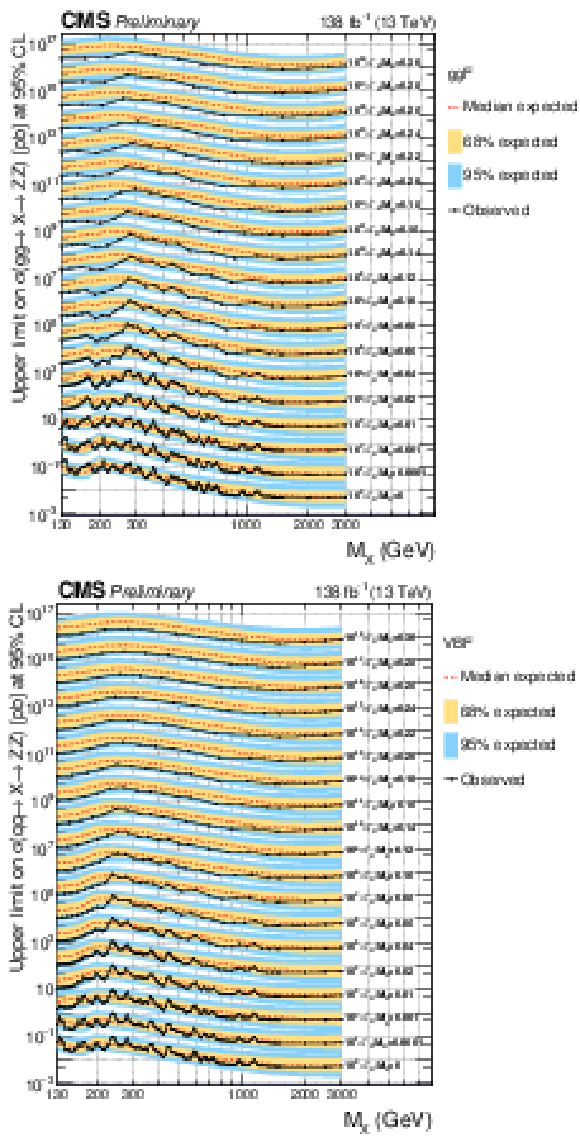
png pdf |
Figure 11:
The observed upper limits on $ \sigma(\mathrm{ pp\to X \to ZZ}) $ with $ M _{\mathrm{X}} $ from 130 GeV to 3 TeV and $ \Gamma _{\mathrm{X}}/M _{\mathrm{X}} $ from NWA to 0.3. The top plot shows the results of pure ggF production and the bottom plot shows the pure VBF production. |

png pdf |
Figure 11-a:
The observed upper limits on $ \sigma(\mathrm{ pp\to X \to ZZ}) $ with $ M _{\mathrm{X}} $ from 130 GeV to 3 TeV and $ \Gamma _{\mathrm{X}}/M _{\mathrm{X}} $ from NWA to 0.3. The top plot shows the results of pure ggF production and the bottom plot shows the pure VBF production. |

png pdf |
Figure 11-b:
The observed upper limits on $ \sigma(\mathrm{ pp\to X \to ZZ}) $ with $ M _{\mathrm{X}} $ from 130 GeV to 3 TeV and $ \Gamma _{\mathrm{X}}/M _{\mathrm{X}} $ from NWA to 0.3. The top plot shows the results of pure ggF production and the bottom plot shows the pure VBF production. |
| Tables | |

png pdf |
Table 1:
Thresholds applied on the $ p_{\mathrm{T}} $ of the leading/subleading leptons for the single lepton (e, $ \mu $), dilepton (e/e, e/$ \mu $, $ \mu $/$ \mu $), and trilepton (e/e/e, e/e/$ \mu $, e/$ \mu $/$ \mu $, $ \mu $/$ \mu $/$ \mu $) HLT algorithms used in each data-taking period. All values are in GeV. |

png pdf |
Table 2:
Summary of the experimental and theoretical uncertainties used in this analysis. Some experimental uncertainties are calculated for each data-taking periods. Uncertainties affecting only normalization are treated as nuisance parameters with a log-normal distribution, specified as "norm". Those affecting variable shapes are specified as "shape". |
| Summary |
| Searches for a spin-0 resonance decaying to a pair of Z bosons in the 4-lepton final state are performed using the full Run 2 dataset collected with the CMS detector, corresponding to an integrated luminosity of 138 fb$^{-1}$. The mass of the resonance is scanned over a range from 130 GeV to 3 TeV, and different decay width assumptions are tested. A model-independent approach for the signal, background, and interference model is used. No significant excess is observed. Only a fluctuation is seen at 137.8 GeV with the narrow width assumption, reaching a global significance of around 1.85$ \sigma $. The upper limits at 95% confidence level on the production cross section multiplied by the decay branching ratio of $ \mathrm{X}\to\mathrm{Z}\mathrm{Z} $ are calculated for different masses, decay widths and production mechanisms. |
| References | ||||
| 1 | ATLAS Collaboration | Observation of a new particle in the search for the standard model Higgs boson with the ATLAS detector at the LHC | PLB 716 (2012) 1 | 1207.7214 |
| 2 | CMS Collaboration | Observation of a new boson at a mass of 125 GeV with the CMS experiment at the LHC | PLB 716 (2012) 30 | CMS-HIG-12-028 1207.7235 |
| 3 | G. C. Branco et al. | Theory and phenomenology of two-Higgs-doublet models | Phys. Rept. 516 (2012) 1 | 1106.0034 |
| 4 | L. Randall and R. Sundrum | Large mass hierarchy from a small extra dimension | PRL 83 (1999) 3370 | hep-ph/9905221 |
| 5 | W. D. Goldberger and M. B. Wise | Modulus stabilization with bulk fields | PRL 83 (1999) 4922 | hep-ph/9907447 |
| 6 | A. Carvalho | Gravity particles from warped extra dimensions, predictions for LHC | 1404.0102 | |
| 7 | CMS Collaboration | Search for a Higgs boson in the mass range from 145 to 1000 GeV decaying to a pair of W or Z bosons | JHEP 10 (2015) 144 | CMS-HIG-13-031 1504.00936 |
| 8 | CMS Collaboration | Search for a new scalar resonance decaying to a pair of Z bosons in proton-proton collisions at $ \sqrt{s}= $ 13 TeV | JHEP 06 (2018) 127 | CMS-HIG-17-012 1804.01939 |
| 9 | ATLAS Collaboration | Search for an additional, heavy Higgs boson in the $ H\rightarrow ZZ $ decay channel at $ \sqrt{s} = $ 8 TeV in $ pp $ collision data with the ATLAS detector | EPJC 76 (2016) 45 | 1507.05930 |
| 10 | ATLAS Collaboration | Search for heavy resonances decaying into a pair of Z bosons in the $ \ell ^+\ell ^-\ell '^+\ell '^- $ and $ \ell ^+\ell ^-\nu {{\bar{\nu }}} $ final states using 139 $ \mathrm {fb}^{-1} $ of proton-proton collisions at $ \sqrt{s} = $ 13 TeV with the ATLAS detector | EPJC 81 (2021) 332 | 2009.14791 |
| 11 | M. Consoli and L. Cosmai | A resonance of the Higgs field at 700 GeV and a new phenomenology | 2007.10837 | |
| 12 | CMS Collaboration | The CMS experiment at the CERN LHC | JINST 3 (2008) S08004 | |
| 13 | CMS Collaboration | Performance of the CMS level-1 trigger in proton-proton collisions at $ \sqrt{s} = $ 13 TeV | JINST 15 (2020) P10017 | |
| 14 | CMS Collaboration | The CMS trigger system | JINST 12 (2017) P01020 | |
| 15 | CMS Collaboration | Precision luminosity measurement in proton-proton collisions at $ \sqrt{s} = $ 13 TeV in 2015 and 2016 at CMS | EPJC 81 (2021) 800 | CMS-LUM-17-003 2104.01927 |
| 16 | CMS Collaboration | CMS luminosity measurement for the 2017 data-taking period at $ \sqrt{s} = $ 13 TeV | CMS Physics Analysis Summary , CERN, Geneva, 2018 CMS-PAS-LUM-17-004 |
CMS-PAS-LUM-17-004 |
| 17 | CMS Collaboration | CMS luminosity measurement for the 2018 data-taking period at $ \sqrt{s} = $ 13 TeV | CMS Physics Analysis Summary , CERN, Geneva, 2019 CMS-PAS-LUM-18-002 |
CMS-PAS-LUM-18-002 |
| 18 | CMS Collaboration | Electron and photon reconstruction and identification with the CMS experiment at the CERN LHC | JINST 16 (2021) P05014 | CMS-EGM-17-001 2012.06888 |
| 19 | CMS Collaboration | Performance of the CMS muon detector and muon reconstruction with proton-proton collisions at $ \sqrt{s} = $ 13 TeV | JINST 13 (2018) P06015 | CMS-MUO-16-001 1804.04528 |
| 20 | CMS Collaboration | Measurements of production cross sections of the Higgs boson in the four-lepton final state in proton-proton collisions at $ \sqrt{s} = $ 13 TeV | EPJC 81 (2021) 488 | CMS-HIG-19-001 2103.04956 |
| 21 | CMS Collaboration | Measurement of the Inclusive $ W $ and $ Z $ Production Cross Sections in $ pp $ Collisions at $ \sqrt{s}= $ 7 TeV | JHEP 10 (2011) 132 | CMS-EWK-10-005 1107.4789 |
| 22 | S. Alioli, P. Nason, C. Oleari, and E. Re | NLO vector-boson production matched with shower in POWHEG | JHEP 07 (2008) 060 | 0805.4802 |
| 23 | P. Nason | A new method for combining NLO QCD with shower Monte Carlo algorithms | JHEP 11 (2004) 040 | hep-ph/0409146 |
| 24 | S. Frixione, P. Nason, and C. Oleari | Matching NLO QCD computations with parton shower simulations: the POWHEG method | JHEP 11 (2007) 070 | 0709.2092 |
| 25 | Y. Gao et al. | Spin determination of single-produced resonances at hadron colliders | PRD 81 (2010) 075022 | 1001.3396 |
| 26 | S. Bolognesi et al. | Spin and parity of a single-produced resonance at the LHC | PRD 86 (2012) 095031 | 1208.4018 |
| 27 | I. Anderson et al. | Constraining anomalous HVV interactions at proton and lepton colliders | PRD 89 (2014) 035007 | 1309.4819 |
| 28 | A. V. Gritsan, R. Roentsch, M. Schulze, and M. Xiao | Constraining anomalous Higgs boson couplings to the heavy flavor fermions using matrix element techniques | PRD 94 (2016) 055023 | 1606.03107 |
| 29 | S. Goria, G. Passarino, and D. Rosco | The Higgs-boson lineshape | NPB 864 (2012) 530 | 1112.5517 |
| 30 | G. Passarino, C. Sturm, and S. Uccirati | Higgs pseudo-observables, second Riemann sheet and all that | NPB 834 (2010) 77 | |
| 31 | K. Hamilton, P. Nason, E. Re, and G. Zanderighi | NNLOPS simulation of Higgs boson production | JHEP 2013 (2013) 222 | |
| 32 | P. Nason and G. Zanderighi | $ W^+ W^- $, $ W Z $ and $ Z Z $ production in the POWHEG-BOX-V2 | EPJC 74 (2014) 2702 | 1311.1365 |
| 33 | M. Grazzini, S. Kallweit, and D. Rathlev | ZZ production at the LHC: Fiducial cross sections and distributions in NNLO QCD | PLB 750 (2015) 407 | 1507.06257 |
| 34 | J. M. Campbell and R. K. Ellis | MCFM for the Tevatron and the LHC | Nucl. Phys. B Proc. Suppl. 205-206 (2010) 10 | 1007.3492 |
| 35 | J. M. Campbell, R. K. Ellis, and C. Williams | Vector boson pair production at the LHC | JHEP 07 (2011) 018 | 1105.0020 |
| 36 | J. M. Campbell, R. K. Ellis, and C. Williams | Bounding the Higgs width at the LHC using full analytic results for $ \mathrm{g}\mathrm{g}\to \mathrm{e^-}\mathrm{e^+} \mu^- \mu^+ $ | JHEP 04 (2014) 060 | 1311.3589 |
| 37 | M. Bonvini et al. | Signal-background interference effects in $ gg \to H \to WW $ beyond leading order | PRD 88 (2013) 034032 | 1304.3053 |
| 38 | K. Melnikov and M. Dowling | Production of two Z-bosons in gluon fusion in the heavy top quark approximation | PLB 744 (2015) 43 | 1503.01274 |
| 39 | C. S. Li, H. T. Li, D. Y. Shao, and J. Wang | Soft gluon resummation in the signal-background interference process of $ gg(\to h^*) \to ZZ $ | 1504.02388 | |
| 40 | S. Catani and M. Grazzini | An NNLO subtraction formalism in hadron collisions and its application to Higgs boson production at the LHC | PRL 98 (2007) 222002 | hep-ph/0703012 |
| 41 | M. Grazzini | NNLO predictions for the Higgs boson signal in the H $ \to $ WW $ \to l\nu l\nu $ and H $ \to $ ZZ $ \to $ 4l decay channels | JHEP 02 (2008) 043 | 0801.3232 |
| 42 | M. Grazzini and H. Sargsyan | Heavy-quark mass effects in Higgs boson production at the LHC | JHEP 09 (2013) 129 | 1306.4581 |
| 43 | G. Passarino | Higgs CAT | EPJC 74 (2014) 2866 | 1312.2397 |
| 44 | J. Alwall et al. | The automated computation of tree-level and next-to-leading order differential cross sections, and their matching to parton shower simulations | JHEP 07 (2014) 079 | 1405.0301 |
| 45 | S. Frixione, P. Nason, and G. Ridolfi | A positive-weight next-to-leading-order Monte Carlo for heavy flavour hadroproduction | JHEP 09 (2007) 126 | 0707.3088 |
| 46 | CMS Collaboration | Study of the mass and spin-parity of the Higgs boson candidate via its decays to $ z $ boson pairs | PRL 110 (2013) 081803 | |
| 47 | T. Sjöstrand et al. | An introduction to PYTHIA 8.2 | Computer Physics Communications 191 (2015) 159 | |
| 48 | CMS Collaboration | Event generator tunes obtained from underlying event and multiparton scattering measurements | EPJC 76 (2016) 155 | |
| 49 | CMS Collaboration | Extraction and validation of a new set of CMS pythia8 tunes from underlying-event measurements | EPJC 80 (2020) 4 | |
| 50 | NNPDF Collaboration | Parton distributions for the LHC run II | JHEP 04 (2015) 040 | 1410.8849 |
| 51 | S. Agostinelli et al. | GEANT4---a simulation toolkit | NIM A 506 (2003) 250 | |
| 52 | CMS Collaboration | Particle-flow reconstruction and global event description with the CMS detector | JINST 12 (2017) P10003 | |
| 53 | T. Chen and C. Guestrin | XGBoost: A scalable tree boosting system | link | 1603.02754 |
| 54 | CMS Collaboration | Measurements of inclusive and differential cross sections for the Higgs boson production and decay to four-leptons in proton-proton collisions at $ \sqrt{s} = $ 13 TeV | JHEP 2023 (2023) 40 | |
| 55 | M. Cacciari, G. P. Salam, and G. Soyez | The anti-kt jet clustering algorithm | JHEP 2008 (2008) 063 | |
| 56 | CMS Collaboration | Jet energy scale and resolution in the CMS experiment in pp collisions at 8 TeV | JINST 12 (2017) P02014 | |
| 57 | CMS Collaboration | Pileup mitigation at CMS in 13 TeV data | JINST 15 (2020) P09018 | |
| 58 | CMS Collaboration | Identification of heavy-flavour jets with the CMS detector in pp collisions at 13 TeV | JINST 13 (2018) P05011 | |
| 59 | CMS Collaboration | Heavy flavor identification at CMS with deep neural networks | CMS Detector Performance Summary CMS-DP-2017-005, 2017 CDS |
|
| 60 | CMS Collaboration | Performance summary of AK4 jet b tagging with data from proton-proton collisions at 13 TeV with the CMS detector | CMS Detector Performance Summary CMS-DP-2023-005, 2023 CDS |
|
| 61 | Particle Data Group , R. L. Workman et al. | Review of Particle Physics | no.~8, 083C01, 2022 Progress of Theoretical and Experimental Physics (2022) 083C01 |
|
| 62 | N. Kauer and G. Passarino | Inadequacy of zero-width approximation for a light Higgs boson signal | JHEP 08 (2012) 116 | 1206.4803 |
| 63 | M. J. Oreglia | A study of the reactions $ \psi^\prime \to \gamma \gamma \psi $ | PhD thesis, Stanford University, SLAC Report SLAC-R-236, 1980 link |
|
| 64 | CMS Collaboration | Measurement of the Higgs boson mass and width using the four leptons final state | CMS Physics Analysis Summary , CERN, Geneva, 2023 CMS-PAS-HIG-21-019 |
CMS-PAS-HIG-21-019 |
| 65 | The LHC Higgs Cross Section Working Group | Cern yellow reports: Handbook of lhc higgs cross sections: 4. deciphering the nature of the higgs sector | link | |
| 66 | M. Botje et al. | The PDF4LHC Working Group Interim Recommendations | 1101.0538 | |
| 67 | S. Alekhin et al. | The PDF4LHC working group interim report | 1101.0536 | |
| 68 | CMS Collaboration | The CMS statistical analysis and combination tool: \textscCombine | Accepted by Comput. Softw. Big Sci, 2024 | CMS-CAT-23-001 2404.06614 |
| 69 | A. L. Read | Presentation of search results: The CL$ _{\text{s}} $ technique | JPG 28 (2002) 2693 | |
| 70 | T. Junk | Confidence level computation for combining searches with small statistics | NIM A 434 (1999) 435 | hep-ex/9902006 |
| 71 | G. Cowan, K. Cranmer, E. Gross, and O. Vitells | Asymptotic formulae for likelihood-based tests of new physics | EPJC 71 (2011) 1554 | 1007.1727 |
| 72 | L. Demortier | P values and nuisance parameters | in Statistical issues for LHC physics. Proceedings, Workshop, PHYSTAT-LHC, Geneva, 2007 link |
|
| 73 | E. Gross and O. Vitells | Trial factors for the look elsewhere effect in high energy physics | EPJC 70 (2010) 525 | 1005.1891 |

|
Compact Muon Solenoid LHC, CERN |

|

|

|

|

|

|